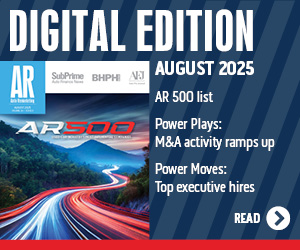Sonic Automotive had record first-quarter used-car sales and March, in particular, was the retailer’s strongest month ever for pre-owned volumes.
The company’s standalone EchoPark pre-owned stores had 1,673 sales during the quarter (up 77.8 percent year-over-year) and could be poised to expand by as many as 20 locations next year.
“If you look at the first quarter, and you look holistically, it’s the first time in a quarter that Sonic Automotive has sold more pre-owned cars than new cars,” executive vice president Jeff Dyke said in an earnings call with the investment community on Wednesday.
“And we expect that to continue to grow,” he said. “The more stores we open up, you’re going to see our used-car business continue to take a commanding lead in the overall volume and mix of this company. And long-term, profitability-wise, it’s going to take the lion’s share of that, too.”
There are currently five EchoPark locations in Colorado, with the next stops being Texas and the Southeast. Last year, Sonic purchased AutoMatch — a group of four used-car stores in Georgia and Florida – and is converting those outlets into EchoPark locations.
“Our stores, on a same-store basis, year-over-year, cash flow was just about break-even for the quarter. Our original stores are making money,” Dyke said. “That’s why we’re pushing forward so hard with EchoPark — (we are) very, very excited about that. Our throughput is great. Our volume growth is excellent.”
He added: “We could not be more excited about EchoPark and the opportunity that we have there. It is just going gangbusters in Denver and we’ve already broken ground in San Antonio (and) Dallas, and the Carolinas will be just behind that.
“We’ll probably get the AutoMatch stores all converted this year, and three or four stores open by the end of the fourth quarter,” he said. “And then we could have the opportunity to open 15 to 20 stores next year.”
Opening new locations for Echo Park
Dyke was asked about weighing the decision to build EchoPark stores (which it is doing in Texas and Carolinas) versus buying existing stores and converting them (which it is doing with the acquired AutoMatch stores in Florida and Georgia).
He said the company is looking at both: greenfields and acquiring stores to convert.
“It’s just a financial decision. It’s a math equation,” he said. “That’s it.”
The criteria for any store, Dyke said, is to have the ability to hold 400 units of sellable inventory.
“And as we meet those standards, we can pop ’em out like popcorn,” he said. “It’s great because our break-even is at a level where we don’t have to sell that many cars and as we continue to grow the brand in these markets like we’re doing in Denver, we start to see nice profitability out of the stores, and then the question is just, how fast can you grow them?
“We’re 100 percent confident in our ability to make money out of them. We’re 100 percent confident in our ability to sell a lot of cars. The big trick is getting your footprint where you want it at the price you want, and then getting it approved by the local governments, which aren’t sometimes as keen as you might believe on having a used-car facility opened up.”
However, Sonic’s experience is that once it has presented to localities, they have achieved a “100-percent success rate” at getting greenlit.
Tech update
Among other technology updates discussed, Sonic said it will introduce an appraisal app “in coming months.”
Perhaps most significant, Sonic customers will be able handle the entire transaction online, Dyke said.
“They’ll be able to buy a car online and we’ll deliver, white-glove, the car to their place of business, their home, wherever they would like,” Dyke said.
He added: “I know it’s not a large part of the customer base today but we project that over time, that’s going to grow and that opportunity will be there for our consumers to use at their convenience.”
Just like when trying to turn used vehicles, Penske Automotive Group chairman Roger Penske also sees an inventory mismatch when dealer group stores look to put their customers into a lease for a new model.
Penske addressed the new-vehicle leasing situation and the potential impact on residual values when the dealer group hosted its quarterly conference call as the company also touted the success of its standalone used-vehicle operations.
“I think right now you’ve got to step back and look at what the marketplace is demanding and it’s demanding SUV and trucks,” Penske said. “I don’t think that the supply base is matched with what’s being sold at the moment.
“So that’ll take some pressure potentially off incentives if the manufacturers can produce enough trucks and SUVs and slow down the sedan,” he continued. “From a residual standpoint, I think there’s no question that that’s been a tool, it’s been in the background that the manufacturers’ finance subsidiaries have been able to do manage through up or down movement of the residuals to affect the realistic payment in the marketplace.”
Penske reiterated that decisions about production, incentives and residual values are all made by the automakers, not dealers. Those choices are all the more important in the luxury segment, according the dealer group boss.
“We have to have a competitive lease rate, and we’re seeing most of our leases in the premium luxury being approximately 30 to 36 months,” Penske said. “There’s no question that that’s a great length of payment because we get that customer back in.”
More on used-car stores
As previously reported by Auto Remarketing, Penske posted a used-vehicle performance lift during the first quarter thanks in part to the addition of U.S.-based CarSense and U.K.-based CarShop, both of which are stand-alone specialty retailers of used vehicles.
During Q1, Penske reported these used-vehicle dealerships retailed 8,200 units. The investment community questioned if Penske wanted to collect more operations like CarSense and CarShop.
“Well, there are a number of smaller used-car businesses around the U.S. We’ve looked at some of these,” he replied. “Some of them are tied to finance companies and other aspects of the used business. I would have to say our mission probably right now both in the U.K. and the U.S. will be greenfield sites to grow.
“The good news is they have a model that’s working,” he continued. “We understand the compensation metrics. We have a parts and service business, which gives us an advantage because of the units in operation. That’s one thing you got to remember that there’s still a parts and service metric on this particular business, and I think that’s one of the benefits buying an existing business.”
So is Penske ready to make more deals in the U.S. or the U.K.?
“I can assure you that I’m sure everyone that’s in the space is going to be looking to see is there anybody out there could be an acquisition, and if there is, I’m sure we’ll be knocking on the door,” Penske said. “But at this point, I don’t have anything that would be meaningful that we would tuck in.”
Imbalance in the mix
Especially here in the U.S., Penske is watching the wholesale market to find the specific vehicles dealer group customers want. And like in the leasing space, SUVs and the like are in demand. Cars? Not so much.
Penske indicated his used-car inventory stands about 39 days.
“We need more vehicles,” he continued. “We certainly see that as we look at our used-car superstores from the standpoint of having enough inventory to continue to grow. I think we got to learn how to be able to buy right at these auctions and look at the OEM auctions to get vehicles.”
“The supply of the right vehicles might be a little bit tough because the mix has changed,” Penske went on to say. “People today want trucks and SUVs. There seems to be an oversupply of used sedans coming through. So, we’re going to balance that out in inventory over the next several months.”
Digital presence
Like many of his dealer group contemporaries, Penske also was asked about online retailing, especially as Carvana gains more steam with additional sales and its initial public offering.
Penske highlighted online volume to company stores is up about 12 percent year-over-year with the dealer group updating websites with “responsive designs.” He added that 50 percent of the group’s site traffic comes through mobile devices.
“So we have to be on top of that,” he said.
Penske also noted the dealer group has the online capability to help customers through what he called “preferred purchase.” The process can help potential buyers evaluate their trade-in value, gather information about financing and more before they arrive at the dealerships.
And if the customer doesn’t want to go to the store to complete deliver?
“We certainly feel from an overall standpoint, the ability for us to deliver a car to a home or to do it to an office is certainly something that’s viable, and we do that already,” Penske said.
While also addressing current industry developments such as Carvana’s financial moves and new-vehicle inventory levels, AutoNation chairman and chief executive officer Mike Jackson touched on what used models are “worth a premium in the marketplace.”
And what Jackson described within that “premium” category likely aren’t necessarily the models that currently might be in your certified pre-owned inventory.
“There is some volatility in the pre-owned market,” Jackson said during AutoNation’s latest quarterly conference call. “If you’re looking for something that was built in 2008, 2009, 2010, there’s relatively small supply since there was little production in those years. And so those vehicles are worth a premium in the marketplace.”
Jackson elaborated about what else is trigging that “volatility,” moving on to what’s composing the off-lease channel on the wholesale market where many potentially certified units could be procured.
“There’s a lot of late-model stuff coming off lease,” Jackson said. “The issue is, more than anything, is it’s the wrong mix because the install capacity three, four years ago was heavily weighted towards cars, and that’s where the marketplace was pushed, even though there was already a strong migration towards trucks.
“So therefore, you have a mismatch between what the market wants to buy and what’s coming back to market. So you have some residual value pressures there,” he continued.
“So at the end of the day, it depends on what seat you’re in,” Jackson went on to say. “If I’m in a seat where I’ve made a bet on residual values three, four years ago, and now you have this wave coming back with a mismatch in mix, I better have set up enough reserves for that because it’s going to be an issue.”
Reaction to Carvana
Wall Street watchers asked for Jackson’s reaction to the efforts by online retailer Carvana, which rolled out a $100 million initial public offering at the end of the first quarter. Jackson began with a blunt assessment when asked to compare Carvana and AutoNation.
“I would say the first difference is we’re profitable and they’re not, so that’s the starting point,” Jackson said. “I’d match our digital capabilities with anyone and they’re only going to get better.
“We started years ago. We understood that to compete in this marketplace, digital was going to be crucial,” he continued. “It was the reason we left behind local market brand names that were 100 years old, because to compete in digital, you need one name.
“And so we took the lead, built the brand AutoNation and then we understood that it had to be – your digital site had to be transactional, people had to be able to do things and we’re well on our way,” he added.
As Jackson hailed the online capabilities AutoNation has, he also reiterated the importance of the rooftops and showrooms the dealer group operates. Carvana’s physical structures include eye-catching vending machines for its vehicles, but otherwise the online retailers often comes to where the customer is located.
Jackson insisted that the “practical experience” AutoNation possesses means that 99 percent of customers “want to come to a physical place, examine the vehicle, have the right to change their mind to something else.
“And here’s one of the great ironies,” Jackson continued. “(Customers) feel more empowered, in control in a dealership than they do in their own driveway, because it’s awkward in their driveway when the car just shows up, and they look at it and say, ‘Oh, that’s not what I hoped for. How do I get out of this mess and how I get this thing out of my driveway?’ They don’t like it.
“So we think we have it figured out, this right combination of brand, digital muscle and brick and mortar. And we’ll see that unfold over the next year,” Jackson went on to say.
Assessment of new-vehicle inventory
As has been the discussion of the American International Automobile Dealers Association as well as a wide array of analysts, new-vehicle inventory is high. Jackson said AutoNation’s new-model inventory is “fine,” sitting at 71 days as of the close of the first quarter.
“I think the basic statement is if I look at the level of inventory and the production plans, basically the decision has already been made,” Jackson said. “The industry will sell over 17 million vehicles this year. That is not the variable. The variable is the level of incentives and the level of leasing. For 2017, the die is cast. It’s plus 17 million units.”
Jackson acknowledged many industry observers will be wondering what 2018 might hold. He stated the decisions OEMs make this summer and fall will impact that timeframe.
“If the plan is to take incentives up another level to try to drive another 17 million-plus, I don’t know whether that’s doable or not,” Jackson said. “Our only variable is how high are the incentives and where are they packaged.”
Penske Automotive Group posted a used-vehicle performance lift during the first quarter thanks in part to the addition of U.S.-based CarSense and U.K.-based CarShop, both of which are stand-alone specialty retailers of used vehicles.
During Q1, Penske reported these used-vehicle dealerships retailed 8,200 units, generating $143.1 million in revenue and $24.6 million in gross profit. The average transaction price was $14,372, generating a gross profit per unit of $1,382. Finance and insurance gross profit per unit was $1,147.
All told, according to the financial statement Penske released on Wednesday, the dealer group retailed 62,284 used units during the first quarter. A year earlier, the figure came in at 52,741 units.
On a same-store basis, however, Penske sustained a slight softening in used-vehicle retail sales as that metric was 51,852 units.
Gross profit on used retail sales on a same-store basis also ticked a bit lower year-over-year as Penske reported the Q1 figure at $1,549, down from $1,601 a year earlier.
However, F&I gross profit per unit improved a bit year-over-year when looking at the same-store data, edging up to $1,123 from $1,066.
Overall, Penske reported that its first quarter included record revenue, income from continuing operations and earnings per share.
The dealer group said Q1 income from continuing operations attributable to common shareholders increased 4.9 percent to $83.2 million, and related earnings per share increased 7.8 percent to $0.97, when compared to the same period last year.
Penske acknowledged foreign exchange negatively impacted income from continuing operations attributable to common shareholders by $7.5 million, and earnings per share attributable to common shareholders by $0.09.
Excluding the foreign exchange impact, the company explained income from continuing operations attributable to common shareholders would have increased 14.4 percent to $90.7 million and earnings per share would have increased 17.8 percent to $1.06.
The company added total revenue increased 5.3 percent to $5.1 billion, but same-store retail revenue declined 2.2 percent. Foreign exchange rates negatively impacted revenues by approximately $287.6 million.
Excluding the foreign exchange impact, total revenue would have increased 11.3 percent to $5.4 billion and same-store retail revenue would have increased 3.7 percent, according to the company.
Penske Automotive Group chairman Roger Penske said, “Our diversified transportation services business delivered another outstanding quarter of record results despite foreign currency headwinds. I am pleased to see increases in average gross profit per transaction for new vehicles, used vehicles and finance and insurance when excluding the impact from foreign exchange, coupled with another strong quarter of record results by our U.K. business.
“As we look to the future our recent acquisitions combined with the continued performance of our existing business provide a solid foundation for growth and profitability,” he went on to say.
Black Book announced on Tuesday that it now powers the online trade appraisal resource for NsightLive, a content engagement company that works to deliver leads to dealers through its Live content platform that creates content experiences to increase customer engagement levels.
“With Black Book’s trade appraisal engine, NsightLive is filling the void for independent auto dealers who currently do not have a trusted trade appraisal tool that can be used online,” Black Book said in a news release. “Independent dealers can level the playing field leading to more successful sales transactions, especially since a more transparent valuation of a vehicle trade reduces friction between customer and dealer.”
At one independent auto dealership, Black Book said a recently completed Beta test showed online lead conversions jump by 50 percent.
"In today's world of online-first research when shopping for a vehicle, it's critical for dealers to provide the most accurate trade appraisal possible in order to build a stronger, more trusting relationship with the customer," Black Book senior vice president of sales Jared Kalfus said. "We're excited to partner with NsightLive and we believe their pioneering online content engagement platform will be a game changer for both independent and franchised dealers."
Aside from trade appraisals powered by Black Book, the platform showcases complete dealer inventory, available credit options and dealer reviews accessible to shoppers.
NsightLive also offers dealers a Hispanic certification program, whose offerings include credit, trade, dealer reviews, community events and dealer involvement within the local Hispanic community.
"We are excited to be a marketing partner with NsightLive and its content engagement platform because it helps level the playing field for independent dealers looking to attract more customers, build stronger relationships and sell more cars and trucks," said Paul John, executive director of the Georgia Independent Auto Dealer Association. "With Black Book powering NsightLive's online trade appraisal resource, customers will receive an accurate appraisal value on their trade in, which will increase efficiency of the transaction, give the buyer more control of the process, as well as give used car buyers the confidence to complete more purchase transactions with their local independent auto dealership."
Additionally, NsightLive offers social content integration for franchised dealers seeking to increase social engagement directly on their websites.
For more information on NsightLive's "Live" digital platform, visit www.NsightLive.com.
AutoNation chairman and chief executive officer Mike Jackson is confident two of the most important used-vehicle performance metrics — volumes and gross profit per unit — will both improve during the second quarter.
According to AutoNation’s first-quarter figures shared on Tuesday, the dealer group reported gains in retail volume but softening in gross.
As a whole, AutoNation retailed 60,608 used vehicles in Q1, up by 2,505 units or 4.3 percent year-over-year. When looking on a same-store basis, the retail figure improved slightly more; up by 5.7 percent as those operations moved 59,131 units.
The gross profit on those units is where AutoNation took it a bit on the chin in Q1.
Overall, AutoNation said its gross profit on used-vehicle retail sales dropped by $377 or 23.4 percent to settle at $1,236. The same-store metric was about the same, sinking by 23.8 percent or $389 to come in at $1,243.
“During the first quarter, we saw increasing used unit volumes as we focused on our One Price strategy, which is now fully rolled out at all AutoNation stores, and worked through the majority of the inventory that was previously on recall hold,” Jackson said in a news release.
“We expect to see a sequential increase in the second quarter in both used unit volumes and gross profit per vehicle retailed,” he continued.
Looking at the top-line performance, AutoNation reported Q1 net income from continuing operations came in at $98 million, or $0.97 per share. A year earlier, it was $96 million, or $0.90 per share.
The dealer group added that its Q1 revenue of $5.1 billion and gross profit of $820 million were relatively flat compared to the year-ago period.
Also of note from AutoNation’s Q1 report, the dealer group indicated that its overall F&I gross profit per unit also stayed nearly flat year-over-year, coming in at $1,625.
Furthermore, AutoNation retailed 75,798 new models during Q1; an amount off by 3,209 units or 4.1 percent year-over-year.
After articulating various points about what he’s so upbeat about the dealer group’s used-vehicle department current and future performance, Lithia Motor president and chief executive officer Bryan DeBoer staunchly defended how the company is fending off what the investment community is seeing as would-be challengers that operate solely online.
During Lithia's latest conference call, when it highlighted its first-quarter results — which included nearly 31,000 used-vehicle retail sales — one participant didn’t mention the online retailer by name but made an insinuation regarding Carvana since that operation recently rolled out plans for an initial public offering. When the questioner asked how Lithia can compete with retailers such as Carvana that function online and go to the potential buyer where they are, DeBoer began by stating, “Lithia Motors is already there.”
DeBoer said the dealer group “probably” sells 40 percent of its used vehicles via what he called “end-to-end solution.”
He continued by saying, “I really believe that auto retailers have built a model that’s an end-to-end solution, where it’s a living room to living room model. We have applications, we have websites, and we have the inventory to do that and we do it at a profitable level, an extremely profitable level.
“And I think when you start to think about sector killers, or people that could modify what the used car model is, I think you need to go back and look at what’s occurred in those segments and understand that auto retailers and especially Lithia Motors that is very adept at selling used vehicles that’s built into who we are and has been built in for the last decade or so,” DeBoer went on to say.
“And I think most importantly, remember, the top of the food chain is the new car trade-ins, OK. And that’s something that used car retailers aren’t at liberty to have, which is what creates that waterfall effect,” he added.
Certainly Lithia could end up with a sizeable amount of trades since the dealer group reported that it retailed 35,616 new models during the first quarter, representing an 8.8-percent lift year-over-year. DeBoer noted that if a Lithia store doesn’t have particular pieces of used inventory that managers deem to be necessary, he’s encouraged by the opportunity to procure those units via wholesale channels.
“The past half-decade of results have been stunted by the lack of vehicle supply, a trend which is finally reversing,” DeBoer said during his opening remarks.
“We’re pleased to see that that supply chain is getting a little looser,” he added later in the conference call. “And with those people out there now understanding what vehicles to procure and which ones build demand from our consumer base, we’re going to continue to build upon that positive impact of supply increase.”
DeBoer also mentioned that Lithia likes to keep between one and two months’ worth of used inventory at its stores. He believes that’s the correct level to push each store toward the goal of retailing at least 75 used vehicles each month.
Update on acquisition activity
Lithia certainly has been active on the acquisition front during the past couple of years, including the procurement of DCH Auto Group in the summer of 2014 and then the Carbone Auto Group last September.
DeBoer did more than hint that the company is far from done expanding its footprint.
“I think when we think about acquisitions at Lithia Motors, this is something that perpetuates in each and every leader in the organization, here in Medford or in the stores,” DeBoer said. “It’s a day-to-day process that each of us are looking for growth opportunities.
“If we look at the physical market, it is the most robust market that we probably ever seen,” he continued. “We believe that pricing is starting to equalize where sellers are asking relative prices to what buyers can be expected or willing to pay and I believe that the coming quarters and years will be a good acquisition climate.”
DeBoer pointed out that the amount of cash Lithia generates annually — $200 million to $300 million — gives Lithia the flexibility to make the moves it chooses. Furthermore, he said Lithia is seeing synergies of blending together its portfolio of stores.
However, the Lithia boss reiterated that it’s an ongoing process.
“We want to build market share, we want to build stability and we want to build those margin improvements and those revenue growth over a period of time,” DeBoer said. “To be fair, it can take two, three, four, five years to be able to build upon that foundation, which is what creates that organic dry powder which allows us to continue to grow our same store sales to reach potential within those new acquisitions. It just takes some time.”
On new-vehicle incentives
Another hot topic DeBoer addressed stemmed from incentives being slapped onto new-vehicle deliveries. Auto Remarketing highlighted the recent analysis from Kelley Blue Book and ALG that mentioned average incentive figures above $3,500 in March.
DeBoer didn’t sound an alarm about what cash is being slapped on the hood or other carrots automakers might be using to get consumers into a new vehicle.
“I think we are not seeing large changes or any type of scenarios that we believe in the next coming quarters are going to change dramatically,” he said. “We typically see pretty stable incentives throughout the summer months. As we begin to move into the fall is when incentives start to accelerate.
“I think as we start to look at the build of vehicle, we’re obviously still overproducing for what the current SAAR run rates are, which does lead to those incentives,” DeBoer continued. “But fortunately we’ll be able to be rewarded for those if our inventories are in a controllable position, whereas each individual market can respond separately based of the value proposition that each of those individual stores has created for their individual markets and the consumers.”
Consumers' increased interest in both trucks and SUV’s over sedans is a shift the industry will have to wrestle with even more this year, says John Rickel, senior vice president and chief financial officer of Group 1 Automotive.
“The overall industry, if you go back two years ago, had a 50/50 split between cars and trucks. Last year it got to 60/40 and this year could be 65/35 — that is a massive, massive shift in consumer preference,” Rickel said during Group 1’s presentation at the Bank of America Merrill Lynch 2017 Auto Summit in New York last week, a webcast of which Auto Remarketing viewed.
“Trucks and SUV’s are continuing to go from strength to strength. There’s a lot of customer demand there.”
He points to lower and affordable gas prices as the primary driver of the shift.
“If you can have the optionality of a bigger package — basically what a truck or SUV offers of you — most consumers are opting for that and the industry is struggling to catch up with that switch,” he said.
Used-car sourcing
During the presentation, Rickel said his group’s top source for used-cars are customers’ trade-ins.
“When we’re under pressure on the new vehicle sales, we’re not selling as many units — we’re not getting as many trades, and we have to go out to auction to supplement,” he said.
One downside, Rickel said, is that going to the auction to buy inventory can be more costly over time, after factoring in all of the added expenditures dealers incur.
“You’re going to pay a little bit more, you’re bidding against other dealers, you pay an auction fee and you’ve got transportation costs,” he said.
Residual trends in segments
In regards to sedans, within the used-car market in particular, there’s currently some pressure on residuals, according to Rickel.
“A lot of leases were written three years ago and that’s were a lot of volume is coming back,” he said. “We’re seeing a number of our OEM partners that have had to warn on residuals. You’re seeing them pull back somewhat on leasing.”
Rickel said he isn’t too strained about the residual values of trucks and SUVs.
Compared to sedans, trucks have a longer life and a number of consumers of have second order uses for them, he said.
In his 30 years of experience and the lease cycle he has seen, it has been rare that “you get a big, big falloff in truck residuals, so I’m less concerned about that,” Rickel said.
Specifically, if the rebound of the housing industry continues, he said it’s likely that construction workers use of trucks will increasingly secure their current standing in the market.
Rickel also added that if an infrastructure program comes from the Trump administration, it will presumably solidify truck sales as well.
Fueled in part by its used-vehicle department performance, Lithia Motors reported the highest first quarter revenue and earnings per share in company history.
To get to those achievements, Lithia said on Wednesday that its used-vehicle retail same store sales increased 6 percent as the dealer group turned a total of 30,783 units during Q1, representing a year-over-year lift of 3,352 units.
That used volume gain helped to overcome deterioration in gross profit per unit. Lithia reported that its gross on used retail sales dipped by $109 year-over-year to $2,234.
Also helping the company cause was Q1 F&I gross profit ticking up $17 compared to the same time period a year ago to land at $1,307.
However, it’s the top-line metrics that prompted Lithia leadership to cheer.
The company said its Q1 unadjusted net income per diluted share increased 30 percent year-over-year to $2.01 from $1.55. Adjusted net income per diluted share increased 15 percent to $1.78 from $1.55.
Lithia’s Q1 unadjusted net income increased 26 percent to $50.7 million from $40.3 million. Adjusted net income increased 12 percent to $45.0 million, up from $40.4 million.
The company went on to highlight its Q1 revenue jumped 13 percent to $2.2 billion from $2.0 billion.
A few other year-over-year highlights included:
—Total same store sales increased 3 percent
—Service, body and parts same store sales increased 8 percent
—SG&A expense as a percentage of gross profit was 71.1 percent
“Through a disciplined acquisition strategy and strong operational execution, we’re pleased to report our 26th consecutive quarter of record earnings per share,” Lithia president and chief executive officer Bryan DeBoer said. “We grew revenue 13 percent and adjusted earnings 12 percent over last year and a significant number of stores still have ample opportunity to improve.
“Since 2010, we have grown our revenue four-fold and our EPS seven-fold, all while currently maintaining a leverage ratio of less than two,” DeBoer continued. “The ability to flex our balance sheet coupled with our free cash flow provides capacity to continue acquisitions at a similar or accelerated cadence in 2017 and beyond.”
Lithia’s expectations are for its used department to maintain the pace it set during the first quarter.
The company’s guidance projects used-vehicle same-store sales increasing 5.5 percent and used-vehicle gross margin to come in at 11.5 percent to 11.7 percent.
Also of note on the used side, Lithia wholesaled 10,840 units during the first quarter, up by 1,327 units or 13.9 percent year-over-year. The average selling price for those wholesaled units softened by $252 to settle at $6,596.
Car dealerships’ handling of leads outpaces other industries, according to Conversica, a provider of artificial intelligence driven lead engagement software for marketing and sales organizations.
Forty-nine percent of the dealerships in a Conversica study responded to leads within five minutes, which is the ideal window for qualification and conversion.
“Internet leads are an expensive resource, crucial to the success of automotive dealerships,” Alex Terry, chief executive officer of Conversica, said in a news release. “Our annual report offers a snapshot of how dealerships are handling leads today and how that behavior is changing over time. We compared real-world execution with best-practice research to help dealerships see where they’re performing well but also to pinpoint processes that need to improve.”
Conversica analysts examined nine industries and had secret shoppers visit a total of 538 companies, including 59 within the automotive industry.
In addition to the dealership lead response rate presented, the study found that only 6 percent took longer than 24 hours to respond and 25 percent made eight or more attempts to reply to queries.
“There are many things the auto industry is getting right,” Conversica said. “Automotive had by far the highest proportion of top-tier scores, with over one-third of respondents (38 percent) receiving an overall 'A' grade.”
The company said the report also shows that there is room for improvement.
Almost 20 percent of dealers did not respond at all to a direct sales inquiry from their website, according to the annual report.
“And 75 percent failed to make the eight or more attempts that research demonstrates are needed to engage an internet lead,” Conversica said.
Additionally, dealerships that are interested in being included in future reports can submit a request at http://www.conversica.com/4ps-assessment-request.
“There is an abundance of research on the importance of what Conversica describes as the Four Ps—promptness, personalization, persistence and performance—of successful lead engagement,” Conversica added.
“The goal of Conversica’s research was to determine the extent to which auto dealers are putting this information into practice.”
Seventy-four percent of the dealerships examined practiced the four key elements of personalization in their responses.












